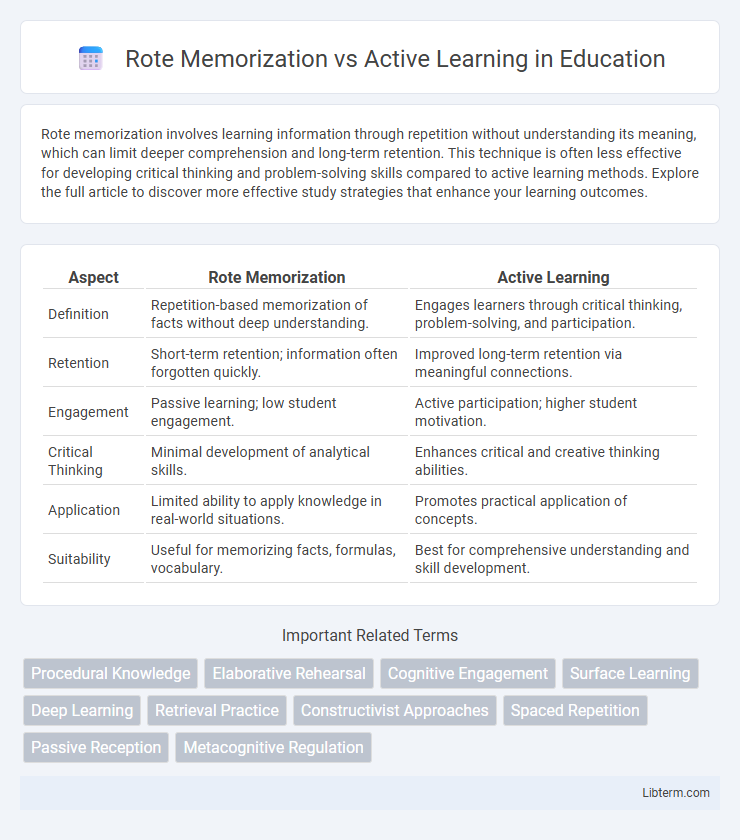Rote memorization involves learning information through repetition without understanding its meaning, which can limit deeper comprehension and long-term retention. This technique is often less effective for developing critical thinking and problem-solving skills compared to active learning methods. Explore the full article to discover more effective study strategies that enhance your learning outcomes.
Table of Comparison
| Aspect | Rote Memorization | Active Learning |
|---|---|---|
| Definition | Repetition-based memorization of facts without deep understanding. | Engages learners through critical thinking, problem-solving, and participation. |
| Retention | Short-term retention; information often forgotten quickly. | Improved long-term retention via meaningful connections. |
| Engagement | Passive learning; low student engagement. | Active participation; higher student motivation. |
| Critical Thinking | Minimal development of analytical skills. | Enhances critical and creative thinking abilities. |
| Application | Limited ability to apply knowledge in real-world situations. | Promotes practical application of concepts. |
| Suitability | Useful for memorizing facts, formulas, vocabulary. | Best for comprehensive understanding and skill development. |
Introduction to Rote Memorization and Active Learning
Rote memorization involves repetitive review and memorization of information without understanding its context, commonly used for facts, formulas, or vocabulary. Active learning engages learners through problem-solving, critical thinking, and applying concepts, enhancing comprehension and long-term retention. Educational research shows active learning improves student performance and conceptual understanding more effectively than rote memorization.
Defining Rote Memorization: Key Characteristics
Rote memorization involves the repetitive recall of information without understanding its meaning or context, emphasizing memorization accuracy over comprehension. Key characteristics include frequent repetition, lack of critical thinking, and reliance on short-term memory retention. This method often leads to superficial learning, limiting the ability to apply knowledge in new or complex situations.
What Is Active Learning? Core Concepts
Active learning involves engaging students directly in the learning process through activities such as discussions, problem-solving, and hands-on tasks, promoting deeper understanding and retention of material. Unlike rote memorization, which emphasizes repetitive recall of information, active learning encourages critical thinking and the application of knowledge in varied contexts. Core concepts include learner participation, immediate feedback, collaboration, and reflection to enhance cognitive processing and long-term mastery.
Historical Context: Evolution of Learning Methods
Rote memorization, a dominant learning method in ancient education systems such as those in Mesopotamia and Ancient India, emphasized repetition and recall of information. Active learning evolved during the 20th century through educational theorists like John Dewey, who promoted engagement and critical thinking as essential to deeper understanding. This shift reflects a broader historical trend from passive knowledge absorption to interactive, student-centered learning models driven by cognitive and constructivist research.
Cognitive Science Behind Rote vs Active Learning
Cognitive science reveals that rote memorization relies heavily on repetitive encoding, engaging short-term memory circuits with limited neural integration, often resulting in weak long-term retention and minimal comprehension. Active learning stimulates deeper cognitive engagement through processes like elaboration, self-explanation, and retrieval practice, which strengthen neural connections in the prefrontal cortex and hippocampus, enhancing long-term memory consolidation and critical thinking. Neuroimaging studies demonstrate increased synaptic plasticity and enhanced metacognitive awareness during active learning, leading to superior transfer of knowledge and adaptive problem-solving skills compared to rote memorization.
Benefits of Rote Memorization in Education
Rote memorization enhances foundational knowledge retention by enabling students to quickly recall essential facts, formulas, and vocabulary, which supports more complex cognitive tasks. It cultivates discipline and consistency in study habits, fostering improved focus and mental endurance in learners. Efficient memorization of core information serves as a reliable scaffold for advanced problem-solving and critical thinking skills in educational settings.
Advantages of Active Learning Approaches
Active learning approaches enhance critical thinking and problem-solving skills by engaging students in interactive activities such as discussions, case studies, and hands-on projects. This method fosters deeper comprehension and long-term retention compared to rote memorization, which often leads to superficial learning. Research from the National Training Laboratory indicates that retention rates soar to 75% when learners participate actively, highlighting the effectiveness of active learning strategies.
Challenges and Limitations of Each Method
Rote memorization faces challenges such as limited long-term retention and poor application of knowledge in practical scenarios, often leading to surface-level understanding without critical thinking. Active learning requires greater cognitive effort and time investment, which can be difficult to sustain for learners with limited motivation or resources, sometimes resulting in inconsistent engagement and progress. Both methods have limitations in balancing depth of comprehension, retention, and learner motivation, highlighting the need for integrating strategies to optimize effective learning outcomes.
Real-World Applications: When to Use Rote or Active Techniques
Rote memorization proves effective for mastering foundational facts like vocabulary, formulas, or historical dates critical in exams or quick recall scenarios. Active learning excels in complex problem-solving and skill development, where understanding concepts and applying knowledge to new situations is essential, such as in project-based tasks or collaborative environments. Choosing between rote and active techniques depends on the learning goals: use rote for rapid retention of discrete facts and active learning for deeper comprehension and real-world application.
Conclusion: Balancing Memorization and Engagement for Optimal Learning
Balancing rote memorization and active learning enhances knowledge retention and critical thinking skills by integrating repetitive practice with hands-on engagement. Effective learning strategies combine memorization of foundational facts with interactive activities that promote problem-solving and conceptual understanding. This dual approach supports long-term mastery and application of complex information across diverse educational contexts.
Rote Memorization Infographic

 libterm.com
libterm.com